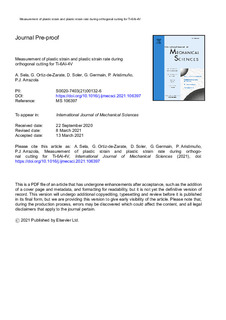Título
Measurement of plastic strain and plastic strain rate during orthogonal cutting for Ti-6Al-4VAutor-a
Autor-a (de otra institución)
Fecha de publicación
2021Versión
PostprintTipo de documento
ArtículoArtículoIdioma
InglésDerechos
© 2021 Elsevier Ltd.Acceso
Acceso restringidoFin de la fecha de embargo
2023-03-31Versión de la editorial
https://doi.org/10.1016/j.ijmecsci.2021.106397Publicado en
International Journal of Mechanical Sciences Editorial
Elsevier Ltd.Palabras clave
plastic strain
DIC
grid distortion
Broaching ... [+]
DIC
grid distortion
Broaching ... [+]
plastic strain
DIC
grid distortion
Broaching
Ti-6Al-4V [-]
DIC
grid distortion
Broaching
Ti-6Al-4V [-]
Resumen
Finite Element Modelling used to predict machining outcomes needs to be supplied with the appropriate material thermomechanical properties which are obtained by specific testing devices and methodolog ... [+]
Finite Element Modelling used to predict machining outcomes needs to be supplied with the appropriate material thermomechanical properties which are obtained by specific testing devices and methodologies. However, these tests are usually not representative of the extreme conditions achieved in machining processes and the obtained material law may not be suitable enough. Inverse identification could address this problem by obtaining material thermomechanical properties directly from machining outcomes such as cutting forces, temperatures, strain or strain rates. Nevertheless, this technique needs to be supplied with accurate machining outcomes. However, some of them such as strain or strain rate are difficult to be properly measured. The aim of this paper is to present a methodology to measure plastic strain and strain rate during orthogonal machining under plane strain conditions. The main idea is to create a physical microgrid in a workpiece and to analyze the distortion suffered by this grid. The novelty of the method consists on its capability of measuring strain and strain rate fields in a very localized area (primary shear zone) using a single image. The methodology was applied in orthogonal cutting of Ti-6Al-4V under cutting conditions that are representative of the broaching process. Experimental results were compared with DIC measurements, analytical results based on unequal division shear zone model, literature results and with numerical fields obtained from an AdvantEdge-2D model. [-]
Sponsorship
Gobierno VascoID Proyecto
GV/Elkartek 2018/KK-2018-00001/CAPV/Investigación colaborativa para la caracterización avanzada de sistemas macroscópicos en la nanoescala/NG18Colecciones
- Artículos - Ingeniería [763]





















